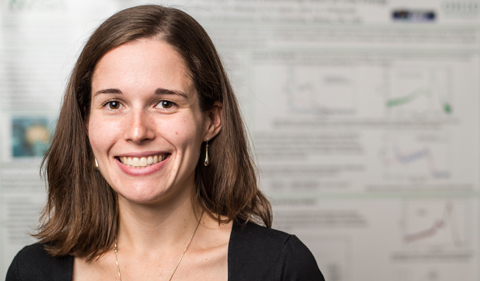
Cody Parker Photo by Rob Hardin
Physics & Astronomy alum Cody Parker spent five days recently conducting experiments at Ohio University’s Edwards Accelerator Lab. Parker is a post-doctoral researcher at the Massachusetts Institute of Technology’s (MIT) Plasma Science and Fusion Center in Cambridge.
Parker graduated in 2016 with a Ph.D. in Physics from the College of Arts & Sciences at Ohio University.
She was accompanied by Neel Kabadi, a physics Ph.D. candidate at MIT. Kabadi is the principal investigator for the experiment and a plasma physics researcher. His specialties include Inertial Confinement Fusion and High Energy Density Physics (HEDP).
Fusion is the combination of fusing lighter ions into heavier ions, and in the process, the difference in mass is converted into energy. This is the method stars – including our Sun – use to produce energy. Stars are nature’s fusion reactor, and the fuel inside the star is held in place by the gravitational pull of the star. In the future, fusion may be a practical source of energy on earth.
Inertial Confinement Fusion, or ICF, is the approach to reproduce nuclear fusion on Earth, and harness it as a source of sustainable, clean energy. Because fusion occurs at a very high temperature and density, one way to confine the fuel for a long enough time for it to fuse and produce energy is using lasers. Lasers are used to drive a spherical target, compressing the fuel inside, and confining it using its own inward inertia. Just as a rocket pushes a spaceship upward, the laser acts as a “spherical rocket”—as it pushes the fusion target inward and compressing it to fusion temperature and density.
Kabadi and Parker are part of a research group at MIT that specializes in studying ICF. The two traveled to OHIO to use the Accelerator to determine the sensitivity of the detectors they brought along to protons of different energies. Their dime-size-diameter detectors are used frequently at the National Ignition Facility at Lawrence Livermore National Laboratory in California, to determine the nuclear bangtime, or the time of the peak of the thermonuclear production, in ICF implosions.
By performing experiments at Edwards Accelerator Lab, Kabadi and Parker hope to get a calibration of the sensitivity of the particle time-of-flight (pTOF) detector to protons of different energies. The set of sensitivity measurements will allow them to understand their detector on a more fundamental level. This is important because the MIT detectors are used regularly at the National Ignition Facility by many research groups.
“This project gave me an opportunity to tune different types of accelerated beam and energy combinations than I had during my time as a graduate student,” Parker explains. “This work is in contrast to the experiments I conducted for my dissertation where I focused on measuring nuclear reactions involving deuterium and tritium, which are of importance to the NIF. In order to study those reactions, I used a deuteron beam with an energy of 500 keV delivered to the beam swinger facility, which is much different to stably tune.”
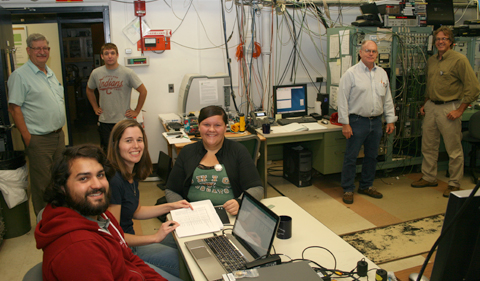
The experiment team includes (background L to R) Dr. Tom Massey, graduate student Doug Soltesz, Don Carter, and Dr. Carl Brune; (foreground) MIT graduate student Neel Kabadi, Dr. Cody Parker, and OHIO doctoral student Andrea Richard. Not pictured: Dr. David Ingram, Devon Jacobs, and graduate student Tyler Danley
In the Q&A below, Parker and Kabadi provide further details about their experiment and interaction with Accelerator faculty, staff, and graduate students.
Q: Why are you using Edwards Accelerator Lab?
The Edwards Accelerator Lab has the capability to produce protons closer to the energy range of interest for protons produced in ICF implosions, which are frequently measured at the NIF. That, coupled with the scattering chamber, allowed for a unique setup that we could customize to fit our needs. Previous measurements on the proton sensitivity on the pTOF detectors at a different accelerator lab could not provide protons above 3.4 MeV in energy.
Another important reason to visit Edwards is that in addition to the continuous proton beams, the option to use pulsed beams with reliably-determined timing between the pulses was very important in the study. This allows for a comparison of how the detectors respond based on the beam type, which was not previously done in a systematic manner.
Q: In what ways did the Accelerator Research Staff assist you?
Nuclear Instrumentation Engineer Don Carter helped set up the timing on the detectors by testing different electronics modules and setups in the experimental area. He also helped OHIO physics doctoral student Andrea Richard, who regularly works with the scattering chamber, with the beam testing prior to the week of the experiment. Don also helped with the pulsing and bunching of the proton beam for each experiment run and guided Cody and Andrea in operating the accelerator at higher beam energies in this configuration. Basically, without Don, things would not have gone as well.
Accelerator Engineer Devon Jacobs helped to facilitate how to set things up for what was needed for using a pulsed beam. He also started the proton source, ensured the accelerator and vacuum systems were ready for the experiment, and trained Neel to safely work in the lab area.
Q: In what ways did you interact with faculty members?
We had input from three faculty members. Research Associate Professor Tom Massey helped with the timing of the pulsed beam and how to utilize the data acquisition system. He provided guidance on radiation safety for surveying and safely storing the activated detectors.
Physics & Astronomy Chair Dr. David Ingram was instrumental in designing the experiment in the existing scattering chamber and the steps needed to normalize the collected current of protons. Specifically, discussions about the Ohio silicon detectors and the MIT CVD diamond detectors were very helpful in the planning stage.
Edwards Accelerator Laboratory Director Dr. Carl Brune helped us with many calculations and the nitty-gritty details, including looking at angle straggling, energy loss, and other key parameters to help optimize the set-up.
Q: How were graduate students included in conducting the experiment?
Andrea Richard was instrumental throughout the experiment, even before our arrival. She helped us with planning details and later, to configure our detector in the chamber, as well as to assist us with the operational shifts. OHIO doctoral students Doug Soltesz and Tyler Danley lent a hand with the set up the chamber, assisted in data acquisition, and putting things back in the standard configuration at the conclusion.
Q: What was your overall research experience at Edwards?
(Kabadi) The Edwards Accelerator community was extremely helpful and supportive. Several people spent almost a week of their time helping with this project. I’m very grateful.
(Parker) It was wonderful to come to back to my home lab to complete an experiment. I’m thankful that there was the opportunity to operate the accelerator again, which was a significant reason why I chose to attend Ohio University for my Master’s and doctorate degrees. It was an added pleasure to showcase the Lab’s equipment and staff members with my research group at MIT. I look forward to future collaboration.
Photo Highlights
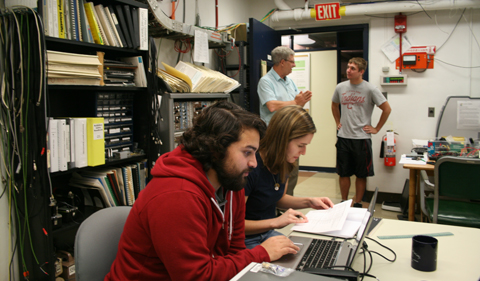
Kabadi and Parker coordinating the written and typed log books for the experiment.
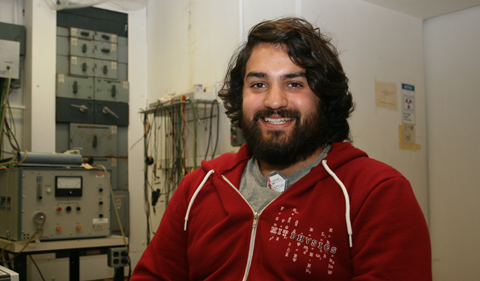
Kabadi studies the effects of having multiple particle types in ICF relevant plasmas, as well as the importance of implosion asymmetry.
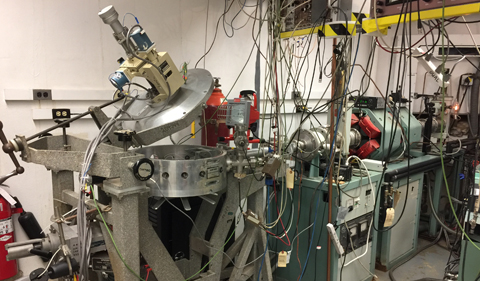
The scattering chamber is open and waiting for adjustments to the detector and cabling set-up inside.
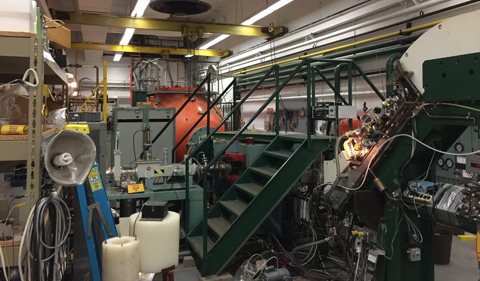
The protons are accelerated in a two-step process in the tandem, bent 90 degrees through the analyzing magnet to filter the energy, and travel toward the left to the small target room after another slight bend through the switching magnet.
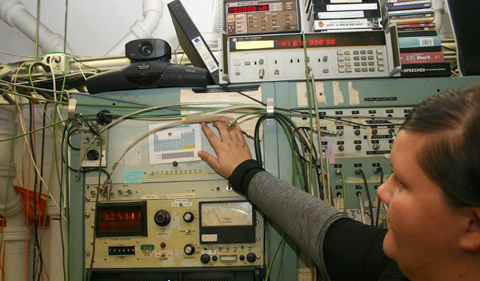
The periodic table is posted near to the data acquisition computer and used as a reference to determine which elements are in the spectrum. Heavier elements show up at higher energies in the spectrum and sometimes the researchers review the order of the elements on the periodic table to identify the peaks.
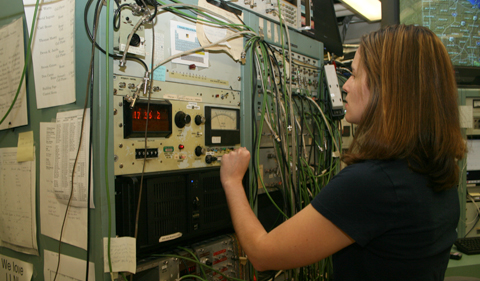
Parker looks at the beam current and charge integration values to make sure that everything is still stable from our initial tuning of the accelerator.
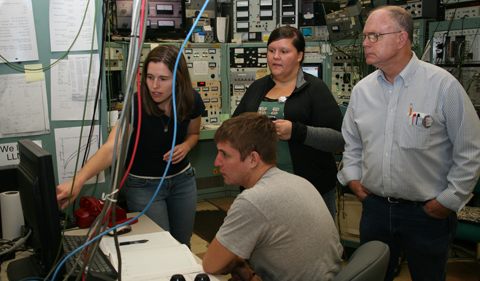
A great way to tackle confusing data is to discuss it in a group setting. Part of the team looks at the RBS spectrum to determine which peaks belong to different elements.
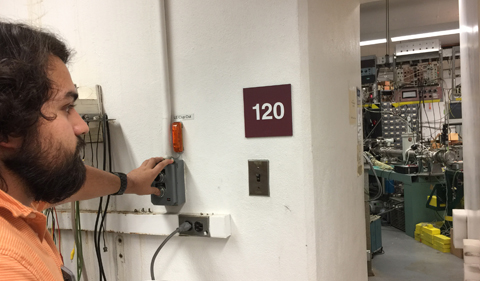
Kabadi is closing the radiation door after making some adjustments in the Small target room. The doors are one-meter-thick high-density concrete used to shield those in the control room from radiaiton produced from the experiment.
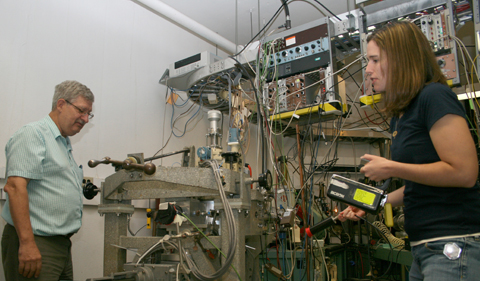
Parker and Massey use a Geiger-Mueller counter to check for activation in the chamber. Massey is in charge of radiation safety in the lab, and helps guide researchers what levels are acceptible for working in an area, as well as if special precautions are needed for moving or storing equipment.
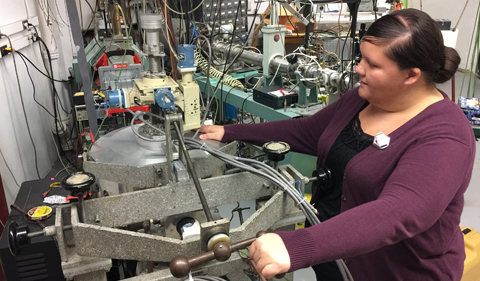
Richard opens the chamber in order to make modifications to the setup or to remove samples and detectors from the chamber.
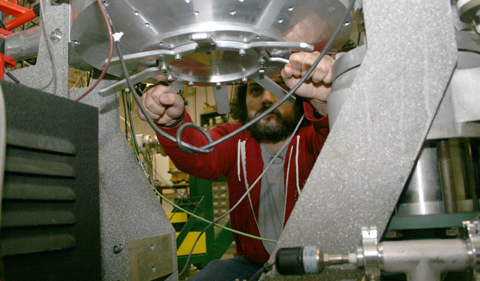
During the experiment, the angle at which the MIT detector is placed can be adjusted by rotating the stand from below, which saves time because the chamber does not need to be opened and then pumped down between each run.
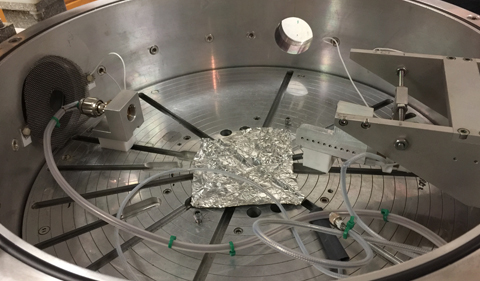
The inside of the scattering chamber was modified for the MIT experiment to allow the detector at the left to be included in a rotatable track location.
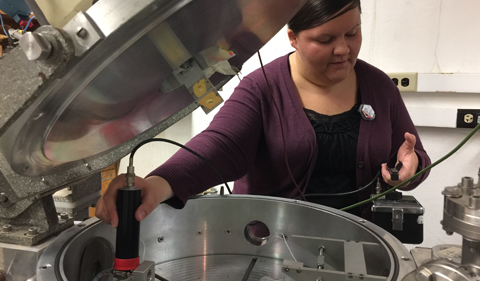
When high energy protons hit the detector or other parts of the chamber, things can become activated with radiation due to reactions of the protons with the materials. Richard is using a Geiger-Mueller counter to determine the level of activation for the MIT detector.
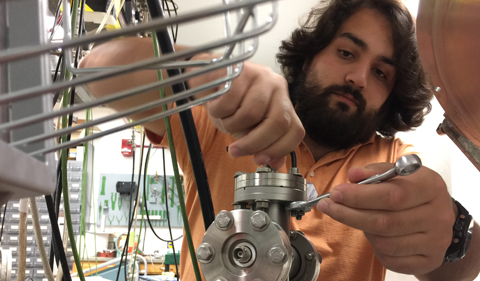
The vacuum-tight feedthrough for the MIT detector needed to be removed from the original set-up.
From the end of the scattering chamber, looking in, one can see the Ohio silicon detector’s small circular aperture toward the right, and the rectangular-collimated beamline where the protons enter in the center.
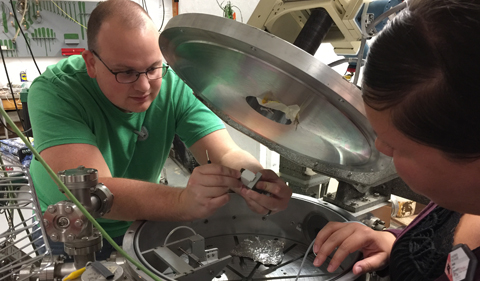
In order to accommodate the MIT experiment, the normal configuration for the detectors for RBS work was altered. At the end of the experiment, Danley and Richard return the chamber to its original configuration by installing a second silicon detector in the rotatable track.
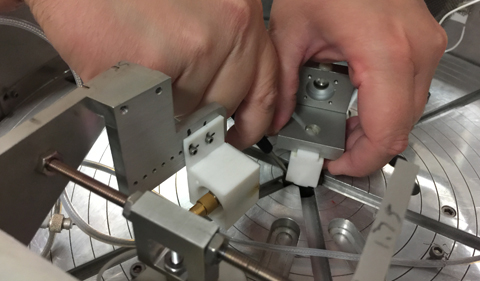
The detectors need to be carefully installed to ensure they are in the correct location and to be sure the insulating materials isolate the detectors themselves from the chamber.
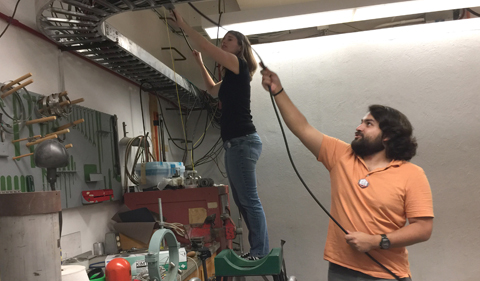
In addition to removing and packing up the detectors, the 95-foot-long power cable needed to be carefully removed from the cable tray in the small target room.
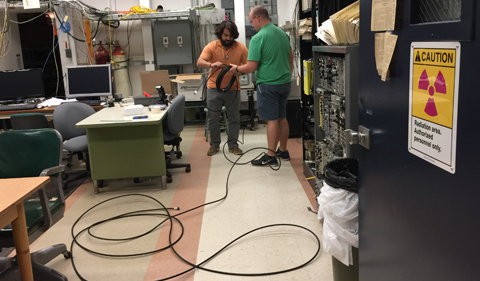
The same cable from the target room was sent through an angled hole in the wall to the control room where it connected to the electronics for the detector, which were not placed in the experimental area due to radiation damage concerns.
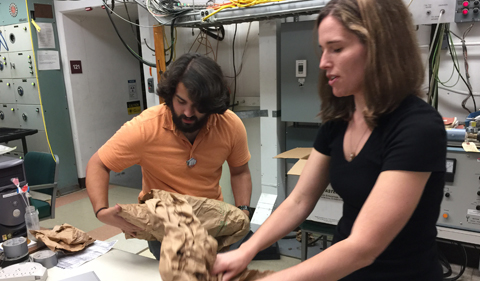
The equipment needed to be packed up and express mailed back to MIT for use by another graduate student to work on a project studying the x-ray sensitivity of the detectors.
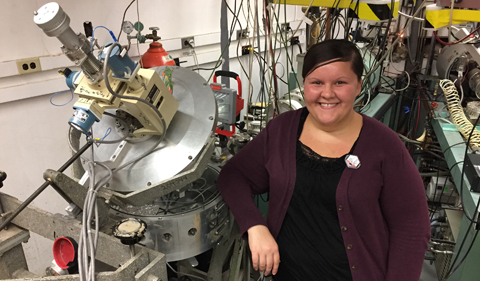
In addition to the data obtained with the MIT detector, Richard has gained experience tuning different accelerator beams and energies into the scattering than she usually does. This can help Andrea or other researchers in the accelerator lab with future projects.



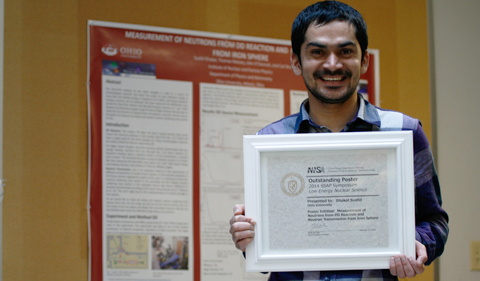















Comments